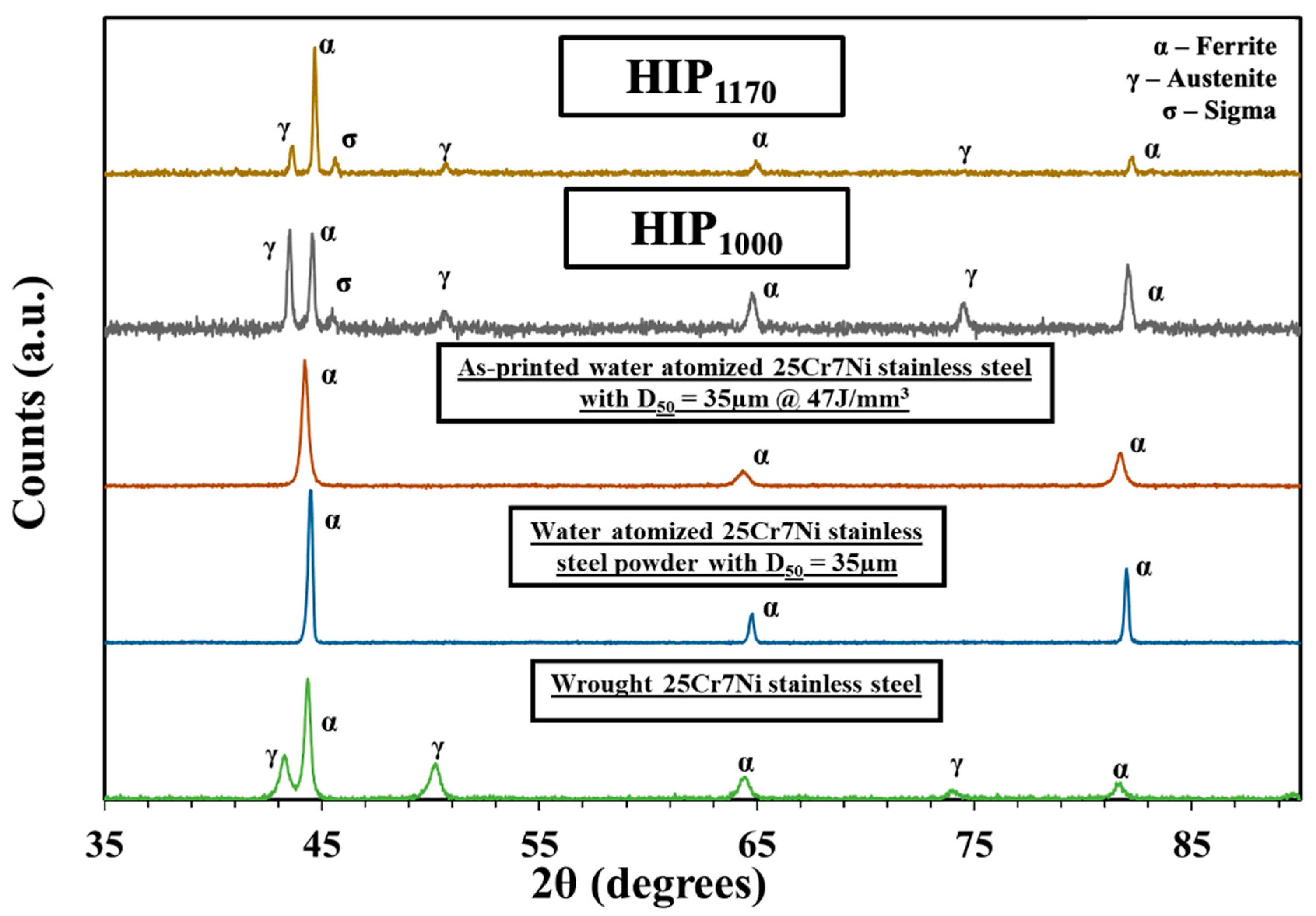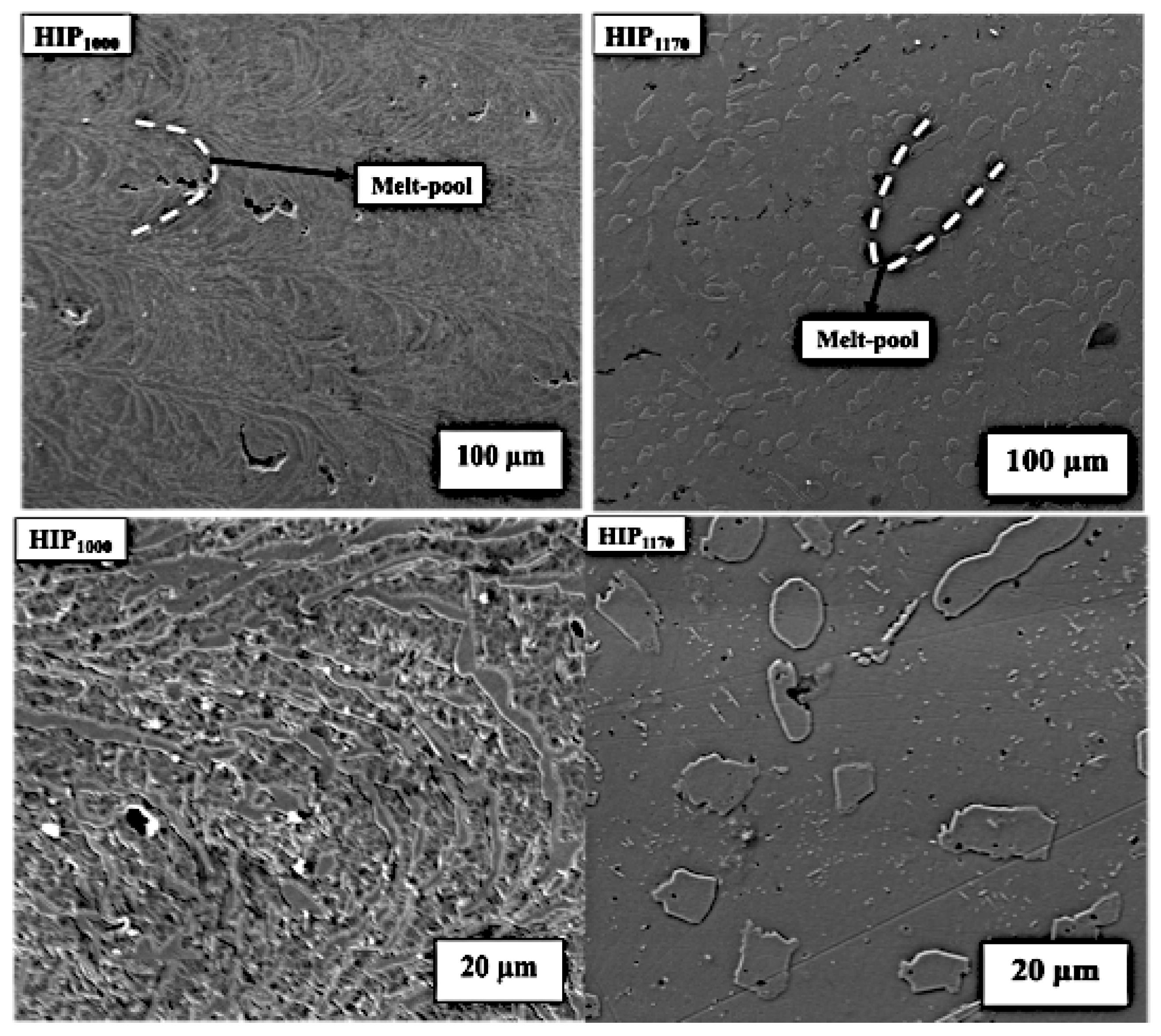Effects of Hot Isostatic Pressing on the Properties of Laser-Powder Bed Fusion Fabricated Water Atomized 25Cr7Ni Stainless Steel
Abstract
1. Introduction
2. Methodology
3. Results and Discussion
4. Summary and Conclusions
- HIP treatment of water-atomized L-PBF as-printed samples resulted in the densification of samples wherein the density of the samples increased from 97 ± 0.1% to 98.4 ± 0.03% and 98.2 ± 0.02% with HIP treatment at 1000 and 1170 °C.
- Both the HIP parameters resulted in the evolution of over 40% austenite in the as-printed samples, promoting a duplex microstructure; XRD analysis revealed peaks correlating to a detrimental σ phase in the HIP-treated samples. The HIP treatment, in terms of average dislocation density, also showed a 2.5-fold reduction in the case of HIP1000 and a 4.4-fold reduction in the case of HIP1170.
- Despite the densification, HIP treatment of the samples resulted in a decrease in the tensile, yield strength, and hardness in both the HIP treatment conditions and a marked increase in the elongation from 12% to 18% was observed under the HIP1000 condition. This was due to over 40% austenite evolution and reduction in dislocation densities.
- A difference in the evolution of the austenite microstructure was observed between HIP1000 and HIP1170 samples, with HIP1000 samples exhibiting a continuous lamellar network of intra-granular grain boundary austenite and inter-granular secondary austenite while HIP1170 samples showed only discontinuous coarsened grain boundary austenite.
- The lack of an increase in elongation in terms of HIP1170 samples in comparison with HIP1000 samples, despite both the samples having over 40% of evolved austenite, can be rationalized through their respective austenite morphologies with the continuous, lamellar grain boundary austenite of HIP1000 samples offering more elongation than the coarsened discontinuous equiaxed grain boundary austenite of the HIP1170 samples.
- The presence of less than 0.1% porosity and over 40% austenite phase in HIP-treated samples resulted in their superior corrosion resistance compared with as printed L-PBF printed samples.
Author Contributions
Funding
Data Availability Statement
Conflicts of Interest
References
- Gunn, R. Duplex Stainless Steels Microstructure, Properties and Applications. Anti-Corros. Methods Mater. 1998, 45. [Google Scholar] [CrossRef]
- Elmer, J.W.; Palmer, T.A.; Specht, E.D. Direct Observations of Sigma Phase Formation in Duplex Stainless Steels Using In-Situ Synchrotron X-ray Diffraction. Metall. Mater. Trans. A 2007, 38, 464–475. [Google Scholar] [CrossRef]
- Chen, T.; Yang, J.R. Effects of solution treatment and continuous cooling on σ-phase precipitation in a 2205 duplex stainless steel. Mater. Sci. Eng. A 2001, 311, 28–41. [Google Scholar] [CrossRef]
- Llorca-Isern, N.; López-Luque, H.; López-Jiménez, I.; Biezma, M.V. Identification of sigma and chi phases in duplex stainless steels. Mater. Charact. 2016, 112, 20–29. [Google Scholar] [CrossRef]
- Iams, A.D.; Keist, J.S.; Palmer, T.A. Formation of Austenite in Additively Manufactured and Post-Processed Duplex Stainless Steel Alloys. Mettal. Mater. Trans. A 2019, 51, 982–999. [Google Scholar] [CrossRef]
- Hengsbach, F.; Koppa, P.; Duschik, K.; Holzweissig, M.J.; Burns, M.; Nellesen, J.; Tillmann, W.; Tröster, T.; Hoyer, K.P.; Schaper, M. Duplex stainless steel fabricated by selective laser melting—Microstructural and mechanical properties. Mater. Des. 2017, 133, 136–142. [Google Scholar] [CrossRef]
- Saeidi, K.; Kevetkova, L.; Lofaj, F.; Shen, Z. Novel ferritic stainless steel formed by laser melting from duplex stainless steel powder with advanced mechanical properties and high ductility. Mater. Sci. Eng. A 2016, 665, 59–65. [Google Scholar] [CrossRef]
- Raffeis, I.; Vroomen, U.; Adjei-Kyeremeh, F.; Großmann, D.; Hammelrath, H.; Westhoff, E.; Bremen, S.; Bozza, D.B.; Bührig-Polaczek, A. Comparative investigations into microstructural and mechanical properties of as-cast and laser powder bed fusion (LPBF) fabricated duplex steel (1.4517). Mater. und Werkst. 2020, 51, 432–444. [Google Scholar] [CrossRef]
- Davidson, K.P.; Singamneni, S.B. Metallographic evaluation of duplex stainless steel powders processed by selective laser melting. Rapid Prototyp. J. 2017, 23, 1146–1163. [Google Scholar] [CrossRef]
- Davidson, K.; Singamneni, S. Selective Laser Melting of Duplex Stainless Steel Powders: An Investigation. Mater. Manuf. Process. 2016, 31, 1543–1555. [Google Scholar] [CrossRef]
- Kunz, J.; Boontanom, A.; Herzog, S.; Suwanpinij, P.; Kaletsch, A.; Broeckmann, C. Influence of hot isostatic pressing post-treatment on the microstructure and mechanical behavior of standard and super duplex stainless steel produced by laser powder bed fusion. Mater. Sci. Eng. A 2020, 794, 139806. [Google Scholar] [CrossRef]
- Cacace, S.; Semeraro, Q. On the Lack of fusion porosity in L-PBF processes. Procedia CIRP 2022, 112, 352–357. [Google Scholar] [CrossRef]
- Akilan, A.A.; Nath, S.D.; Enneti, R.K.; Gupta, G.; Atre, S.V. Mechanical and corrosion properties of gas and water atomized laser-powder bed fusion fabricated 25Cr7Ni stainless steel. Manuf. Lett. 2021, 31, 60–63. [Google Scholar] [CrossRef]
- Sola, A.; Nouri, A. Microstructural porosity in additive manufacturing: The formation and detection of pores in metal parts fabricated by powder bed fusion. J. Adv. Manuf. Process. 2019, 1, e10021. [Google Scholar] [CrossRef]
- Shaikh, M.Q.; Nath, S.D.; Akilan, A.A.; Khanjar, S.; Balla, V.K.; Grant, G.T.; Atre, S.V. Investigation of Patient-Specific Maxillofacial Implant Prototype Development by Metal Fused Filament Fabrication (MF3) of Ti-6Al-4V. Dent. J. 2021, 9, 109. [Google Scholar] [CrossRef]
- Bean, G.E.; Witkin, D.B.; McLouth, T.D.; Patel, D.N.; Zaldivar, R.J. Effect of laser focus shift on surface quality and density of Inconel 718 parts produced via selective laser melting. Addit. Manuf. 2018, 22, 207–215. [Google Scholar] [CrossRef]
- Gu, D.D. Laser Additive Manufacturing of High-Performance Materials, 1st ed.; Springer: Berlin/Heidelberg, Germany, 2015. [Google Scholar]
- Gu, D.; Shen, Y. Processing conditions and microstructural features of porous 316L stainless steel components by DMLS. Appl. Surf. Sci. 2008, 255, 1880–1887. [Google Scholar] [CrossRef]
- Attar, H.; Calin, M.; Zhang, L.C.; Scudino, S.; Eckert, J. Manufacture by selective laser melting and mechanical behavior of commercially pure titanium. Mater. Sci. Eng. A 2014, 593, 170–177. [Google Scholar] [CrossRef]
- Ronneberg, T.; Davies, C.M.; Hooper, P.A. Revealing relationships between porosity, microstructure and mechanical properties of laser powder bed fusion 316L stainless steel through heat treatment. Mater. Des. 2020, 189, 108481. [Google Scholar] [CrossRef]
- Humphreys, F.J.; Hatherly, M. Recrystallization and Related Annealing Phenomena; Elsevier: Amsterdam, The Netherlands, 2012. [Google Scholar]
- Muiruri, A.; Maringa, M.; Du Preez, W. Evaluation of Dislocation Densities in Various Microstructures of Additively Manufactured Ti6Al4V (Eli) by the Method of X-ray Diffraction. Materials 2020, 13, 5355. [Google Scholar] [CrossRef]
- Davanageri, M.B.; Narendranath, S.; Kadoli, R. Influence of heat treatment on microstructure, hardness and wear behavior of super duplex stainless steel AISI 2507. Am. J. Mater. Sci. 2015, 5, 48–52. [Google Scholar] [CrossRef]
- Cronemberger, M.E.R.; Nakamatsu, S.; Della Rovere, C.A.; Kuri, S.E.; Mariano, N.A. Effect of Cooling Rate on the Corrosion Behavior of As-Cast SAF 2205 Duplex Stainless Steel after Solution Annealing Treatment. Mater. Res. 2015, 18, 138–142. [Google Scholar] [CrossRef]
- North American Höganäs. Development of PM Duplex Stainless Steel ( XSS-DP1); North American Höganäs: Johnstown, PA, USA, 1993. [Google Scholar]
- Kisasoz, A.; Karaaslan, A.; Bayrak, Y. Effect of Etching Methods in Metallographic Studies of Duplex Stainless Steel 2205. Met. Sci. Heat Treat. 2017, 58, 704–706. [Google Scholar] [CrossRef]
- Chen, T.; Weng, K.; Yang, J. The effect of high-temperature exposure on the microstructural stability and toughness property in a 2205 duplex stainless steel. Mater. Sci. Eng. A 2002, 338, 259–270. [Google Scholar] [CrossRef]
- Chiang, J.; Boyd, J.; Pilkey, A. Effect of microstructure on retained austenite stability and tensile behaviour in an aluminum-alloyed TRIP steel. Mater. Sci. Eng. A 2015, 638, 132–142. [Google Scholar] [CrossRef]
- Voronenko, B.I. Austenitic-ferritic stainless steels: A state-of-the-art review. Met. Sci. Heat Treat. 1997, 39, 428–437. [Google Scholar] [CrossRef]
- Bayoumi, F.M.; Ghanem, W.A. Effect of nitrogen on the corrosion behavior of austenitic stainless steel in chloride solutions. Mater. Lett. 2005, 59, 3311–3314. [Google Scholar] [CrossRef]




| Stainless Steel | Hardness (HRC) | Ultimate Tensile Strength (MPa) | Yield Strength (MPa) | Elongation (%) | Relative Density (%) |
|---|---|---|---|---|---|
| As-printed L-PBF 25Cr7Ni | 26 ± 0.8 | 1000 ± 15 | 935 ± 17 | 12 ± 0.6 | 97 ± 0.1 |
| HIP1000 | 22.5 ± 1.5 | 900 ± 70 | 560 ± 30 | 18 ± 2 | 98.4 ± 0.03 |
| HIP1170 | 15 ± 1 | 885 ± 62 | 627 ± 32 | 9 ± 2 | 98.2 ± 0.02 |
| Wrought 25Cr7Ni | 29 ± 1 | 860 ± 30 | 580 ± 9 | 30 ± 2 | 100 |
| Specimen | Archimedes Density (g/cc) | Corrosion Current, Icorr (μA/cm2) | Corrosion Potential, Ecorr (V) | Breakdown Potential, Eb (V) | Polarization Resistance, Rp (Ω/cm2) × 105 | Calculated Corrosion Rate (μm/Year) |
|---|---|---|---|---|---|---|
| Water atomized 25Cr7Ni SS HIP1000 | 7.55 ± 0.0 | 0.1 ± 0.01 | −0.29± 0.04 | 1.1 ± 0.0 | 1.5 ± 0.7 | 9.3 ± 4 |
| Water atomized 25Cr7Ni SS HIP1170 | 7.54 ± 0.0 | 0.1 ± 0.0 | −0.3 ± 0.1 | 1.0 ± 0.0 | 2.84 ± 0.6 | 8.35 ± 0.3 |
| Water atomized 25Cr7Ni SS as-printed L-PBF (47 J/mm3) | 7.53 ± 0.1 | 0.3 ± 0.06 | −0.45± 0.01 | 1.05 ± 0.01 | 1.7 ± 0.1 | 19.6 ± 1 |
| Wrought 25Cr7Ni stainless steel | 7.7 | 0.1 ± 0.01 | −0.28 ± 0.05 | 1.01 ± 0.05 | 4.4 ± 0.4 | 5.1 ± 0.7 |
Publisher’s Note: MDPI stays neutral with regard to jurisdictional claims in published maps and institutional affiliations. |
© 2022 by the authors. Licensee MDPI, Basel, Switzerland. This article is an open access article distributed under the terms and conditions of the Creative Commons Attribution (CC BY) license (https://creativecommons.org/licenses/by/4.0/).
Share and Cite
Arumugham Akilan, A.; Enneti, R.K.; Balla, V.K.; Atre, S.V. Effects of Hot Isostatic Pressing on the Properties of Laser-Powder Bed Fusion Fabricated Water Atomized 25Cr7Ni Stainless Steel. Lubricants 2022, 10, 340. https://doi.org/10.3390/lubricants10120340
Arumugham Akilan A, Enneti RK, Balla VK, Atre SV. Effects of Hot Isostatic Pressing on the Properties of Laser-Powder Bed Fusion Fabricated Water Atomized 25Cr7Ni Stainless Steel. Lubricants. 2022; 10(12):340. https://doi.org/10.3390/lubricants10120340
Chicago/Turabian StyleArumugham Akilan, Arulselvan, Ravi K Enneti, Vamsi Krishna Balla, and Sundar V. Atre. 2022. "Effects of Hot Isostatic Pressing on the Properties of Laser-Powder Bed Fusion Fabricated Water Atomized 25Cr7Ni Stainless Steel" Lubricants 10, no. 12: 340. https://doi.org/10.3390/lubricants10120340
APA StyleArumugham Akilan, A., Enneti, R. K., Balla, V. K., & Atre, S. V. (2022). Effects of Hot Isostatic Pressing on the Properties of Laser-Powder Bed Fusion Fabricated Water Atomized 25Cr7Ni Stainless Steel. Lubricants, 10(12), 340. https://doi.org/10.3390/lubricants10120340





